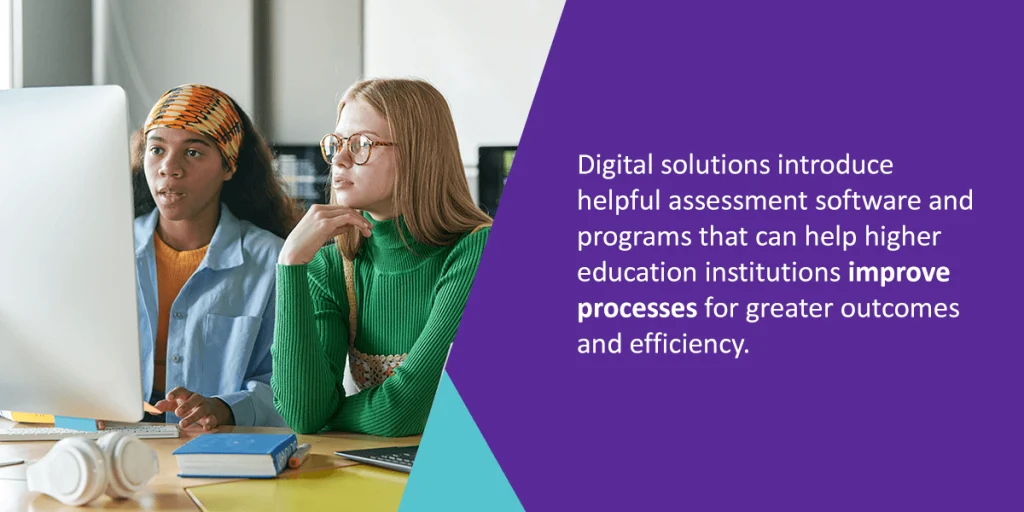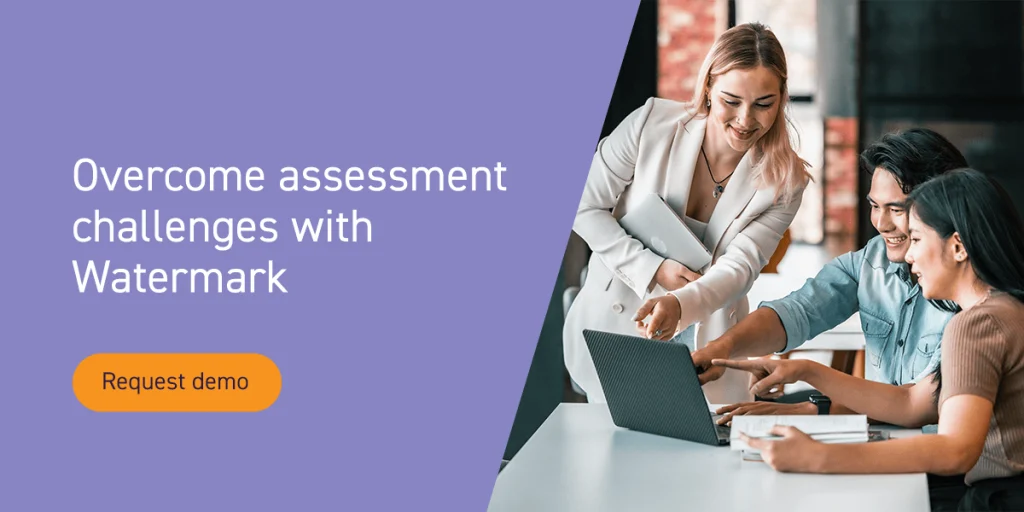




Indirect and direct assessment in higher education requires a combination of direct and indirect measures of student learning, and defining what you’re measuring is only half the battle. There are many ways to amass data for assessment, from test scores to artifact collection and sentiment scores — and things get complicated when it comes time for reporting. What makes it so difficult to track both direct and indirect measures for assessment?
Direct assessment in higher education consists of collecting quantitative data through methods such as exams, faculty evaluations, and assignment rubrics. Indirect assessment is based on qualitative data pulled from measures such as surveys and end-of-course evaluations.
Direct and indirect assessment measures are both important because they reveal different types of information about courses and how well students are learning material to enhance student learning experiences. While direct assessment indicates how well students are able to apply what they learn, indirect assessment indicates how well they feel they are learning the material.
Direct and indirect assessments are incredible tools, but traditional assessment methods can present some challenges. Digital solutions introduce helpful assessment software and programs that can help higher education institutions improve processes for greater outcomes and efficiency.

At some colleges and universities, managing the data for a quality enhancement plan (QEP) and institutional effectiveness plans (IEPs) proves to be an overwhelming endeavor. The process often requires going through piles of paper and PDFs, tallying scores, and manually creating reports in Excel, which introduces the opportunity for errors and omissions. Fortunately, moving to a digital solution eliminates the paper chase.
On top of managing the sheer volume of paper, these institutions’ teams may have to keep faculty engaged and make sure all participants have submitted their documents. This requires an elaborate tracking system to identify and follow up on missing information.
Assessment technology, however, helps automate the data collection and review processes, freeing up administrative time for more value-added work. It decentralizes responsibility so assessment processes don’t fall on one department’s shoulders. Rather than depending on one group of individuals to collect, store, track, and report data, each faculty and administrative member plays a part in the process.
Digital tools help streamline the assessment and accreditation reporting process, but if the solutions aren’t integrated, reporting isn’t as seamless as it could be. Implementing solutions like Watermark Outcomes Assessment Projects to manage a QEP, Watermark Planning & Self-Study to support strategic planning and assessment reporting, and Watermark Course Evaluations & Surveys to gather student feedback helps streamline data collection and create consistent reports.
Course-embedded activities and assignments take time to plan and develop, and faculty must spend additional time grading assignments. Analyzing portfolios can also be time-consuming. Time management is a significant challenge of direct and indirect assessments. Figuring out how to perform assessments and collect and enter data efficiently is essential, and a digital solution can increase efficiency.
Assessment processes can be very labor-intensive. Implementing a digital solution streamlines assessments and data collection so administration and faculty members can focus on important tasks, spending less time collecting, analyzing, and storing data and more time using data to improve educational approaches. Assessment technology eliminates the need for data entry because it automatically transfers results to a dashboard and allows individuals to access quick reports.
Traditional assessment methods typically consist of maintaining PDF files, but a digital solution allows for more interactivity. Rather than keeping data stored away and out of sight, a digital solution allows faculty and administration to continuously work with collected data and use it to improve student learning and experiences.
A traditional assessment method may not provide the insight faculty members and administration need to evaluate a department’s successes and areas for improvement fully. A digital solution allows faculty members to assess learning outcomes and assessment measures simultaneously. The assessment measures move with the learning outcomes each year, so the data automatically updates and allows staff a deeper look into each department’s annual success
Direct and indirect assessment of learning is meant to benefit students and higher education staff, so it’s essential to maintain a closed-loop system. Assessments can present gaps between students, faculty, and administration. A digital solution can effectively combine indirect and direct assessment measures to close the loop between all parties.
As online learning becomes more prevalent in an increasingly digital world, shifting processes is necessary. Managing traditional assessment methods can be challenging when institutions shift to online learning. Digital software helps institutions keep up with the changing educational system and smoothly integrate with online processes.
Higher education institutions can enhance student experiences with direct and indirect assessment processes and software. Combining direct and indirect assessment measures centralizes processes and helps close the feedback loop between students, faculty, and administrators, providing institutions with information they can use effectively.
Digital solutions significantly improve higher education assessment processes, streamlining data collection, storage, tracking, analysis, and usage. Learn more about how Watermark can help your institution overcome these common challenges or contact us to request a demo.






























































































































































































































































































































































































